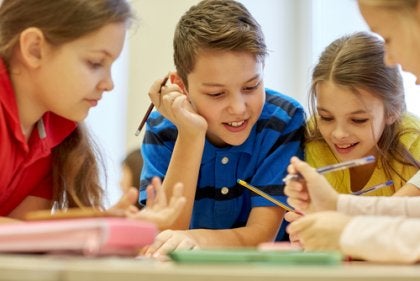Blue Eyes and Brown Eyes: The Jane Elliott Experiment


Written and verified by the psychologist Francisco Roballo
Immediately after the assassination of Martin Luther King Jr., Professor Jane Elliott used the minimal group paradigm to perform an experiment that would teach her students about race discrimination. The minimal group paradigm has shaped an entire methodology in social psychology. Basically, you establish differences between a set of subjects in order to divide them into separate groups. This technique allows researchers to show how many different traits are necessary to create defined groups, and then analyze the subjects’ behavior within their groups.
In the 60s, the United States was in the midst of a social race crisis. Professor Jane Elliott performed a group experiment with her students that they would never forget. The idea was simple but profound. She wanted to show her students that an arbitrarily established difference could separate them and pit them against each other.
Jane Elliott’s experiment
Jane Elliott, a teacher and anti-racism activist, performed a direct experiment with the students in her classroom. She told them that people with brown eyes were better than people with blue eyes. She also made the brown-eyed students put construction paper armbands on the blue-eyed students.

Eye Color
With a couple of basic and arbitrary examples, Elliott made the case that brown-eyed people were better. The students were surprised, but they didn’t argue. This way, she successfully created two distinct groups in her classroom:
- Brown-eyed people. There were more brown-eyed students in the room. They felt superior and had the support of the authority figure (the teacher). The brown-eyed students also exercised a certain level of power over the blue-eyed students when they put the armbands on them.
- Blue-eyed people. This was the smaller group. Elliott said that blue-eyed people were less intelligent and less clean. Not only were they fewer in numbers, but the authority figure was against them.
Discrimination
The consequences of the minimal group became evident very quickly. A difference as simple as eye color, defined and established by the authority figure, created a rift between the students.
The brown-eyed children began to act aggressive and mean towards the blue-eyed children. The latter felt discriminated against by the other brown-eyed children.
What Did the Discrimination Look Like?
Normally, “blue-eyes” isn’t an insult. However, in this classroom, having blue-eyes had become a condition of inferiority. Consequently, the brown-eyed children started using “blue-eyes” as an insult. The brown-eyed children didn’t want to play with the “blue-eyes” during recess. They also harassed them constantly.
The Results of the Experiment
The arbitrary division among the students intensified over the course of the experiment, so much so that it actually ended in physical violence. Children often fight, argue, and sometimes hit each other, but this time they were motivated by eye color. The second day, Elliott reversed the groups. She told the students that the brown-eyed children were inferior and repeated the experiment. The results were the same.
From the Classroom to the Real World
When you read about this experiment, it’s hard not to question labels. If this arbitrary division that Elliott enforced for a few hours created so many problems in this classroom, what’s happening on a larger scale? Considering all the stereotypes and prejudices that exist, what kind of damage is being done?
It’s not surprising to anyone that some social groups discriminate against others due to ethnicity, religion, or culture. These differences lead to war and hate. Even family members can turn against each other if some authority suddenly decides that those differences are a problem.
“I felt like quitting school. I felt mad. That’s what it feels like when you’re discriminated against.”
-A child participant in the Blue Eyes-Brown Eyes experiment-
A Question of Upbringing
Jane Elliott has done a lot of reflection about the consequences of the minimal group experiment. She says that it’s shocking how children who’re normally kind, cooperative, and friendly with each other suddenly become arrogant, discriminatory, and hostile when they belong to a “superior” group.
The hate and discrimination that we see in adults have their origin in their upbringing. Society made them believe they were better than other people for arbitrary reasons such as skin color or gender.

Minimal Groups Today
This paradigm helps understand the current problems related to discrimination. Today, increased migration means more opportunities for people from different backgrounds to interact with each other, which is often a source of conflict.
The people and cultures already present in a place often feel threatened by new immigrants. Their response is to create dichotomies of inferiority and superiority. As a result of those divisions, you see racial discrimination or even terrorism.
The Importance of Discrimination-Free Education
The goal of the minimal group paradigm is to establish subjective differences and create a climate of favoritism. Thus, the dominant group, supported by the authorities, will always have the upper hand. This procedure is sometimes so subtle that no one notices it happening. Some guidelines for avoiding or reducing this effect are:
- Normalize differences. In educational contexts, normalizing superficial differences between children can mitigate feelings of superiority.
- Integration activities. It’s important to mix individuals with different traits, beliefs, and cultures as much as possible and get them working together on a common goal.
- The role of the teacher. In an authoritarian environment, the group closest to the authority figure (in this case, the teacher) feels superior and justified. Consequently, teachers must be mediators, not instigators.
In conclusion, Jane Elliott’s experiment demonstrates the fragility of coexistence and cooperation. It also shows how arbitrary and subjective things can turn friends, family members, and citizens against each other.
“Charity is humiliating because it’s exercised vertically and from above; solidarity is horizontal and implies mutual respect.”
-Eduardo Galeano-
Immediately after the assassination of Martin Luther King Jr., Professor Jane Elliott used the minimal group paradigm to perform an experiment that would teach her students about race discrimination. The minimal group paradigm has shaped an entire methodology in social psychology. Basically, you establish differences between a set of subjects in order to divide them into separate groups. This technique allows researchers to show how many different traits are necessary to create defined groups, and then analyze the subjects’ behavior within their groups.
In the 60s, the United States was in the midst of a social race crisis. Professor Jane Elliott performed a group experiment with her students that they would never forget. The idea was simple but profound. She wanted to show her students that an arbitrarily established difference could separate them and pit them against each other.
Jane Elliott’s experiment
Jane Elliott, a teacher and anti-racism activist, performed a direct experiment with the students in her classroom. She told them that people with brown eyes were better than people with blue eyes. She also made the brown-eyed students put construction paper armbands on the blue-eyed students.

Eye Color
With a couple of basic and arbitrary examples, Elliott made the case that brown-eyed people were better. The students were surprised, but they didn’t argue. This way, she successfully created two distinct groups in her classroom:
- Brown-eyed people. There were more brown-eyed students in the room. They felt superior and had the support of the authority figure (the teacher). The brown-eyed students also exercised a certain level of power over the blue-eyed students when they put the armbands on them.
- Blue-eyed people. This was the smaller group. Elliott said that blue-eyed people were less intelligent and less clean. Not only were they fewer in numbers, but the authority figure was against them.
Discrimination
The consequences of the minimal group became evident very quickly. A difference as simple as eye color, defined and established by the authority figure, created a rift between the students.
The brown-eyed children began to act aggressive and mean towards the blue-eyed children. The latter felt discriminated against by the other brown-eyed children.
What Did the Discrimination Look Like?
Normally, “blue-eyes” isn’t an insult. However, in this classroom, having blue-eyes had become a condition of inferiority. Consequently, the brown-eyed children started using “blue-eyes” as an insult. The brown-eyed children didn’t want to play with the “blue-eyes” during recess. They also harassed them constantly.
The Results of the Experiment
The arbitrary division among the students intensified over the course of the experiment, so much so that it actually ended in physical violence. Children often fight, argue, and sometimes hit each other, but this time they were motivated by eye color. The second day, Elliott reversed the groups. She told the students that the brown-eyed children were inferior and repeated the experiment. The results were the same.
From the Classroom to the Real World
When you read about this experiment, it’s hard not to question labels. If this arbitrary division that Elliott enforced for a few hours created so many problems in this classroom, what’s happening on a larger scale? Considering all the stereotypes and prejudices that exist, what kind of damage is being done?
It’s not surprising to anyone that some social groups discriminate against others due to ethnicity, religion, or culture. These differences lead to war and hate. Even family members can turn against each other if some authority suddenly decides that those differences are a problem.
“I felt like quitting school. I felt mad. That’s what it feels like when you’re discriminated against.”
-A child participant in the Blue Eyes-Brown Eyes experiment-
A Question of Upbringing
Jane Elliott has done a lot of reflection about the consequences of the minimal group experiment. She says that it’s shocking how children who’re normally kind, cooperative, and friendly with each other suddenly become arrogant, discriminatory, and hostile when they belong to a “superior” group.
The hate and discrimination that we see in adults have their origin in their upbringing. Society made them believe they were better than other people for arbitrary reasons such as skin color or gender.

Minimal Groups Today
This paradigm helps understand the current problems related to discrimination. Today, increased migration means more opportunities for people from different backgrounds to interact with each other, which is often a source of conflict.
The people and cultures already present in a place often feel threatened by new immigrants. Their response is to create dichotomies of inferiority and superiority. As a result of those divisions, you see racial discrimination or even terrorism.
The Importance of Discrimination-Free Education
The goal of the minimal group paradigm is to establish subjective differences and create a climate of favoritism. Thus, the dominant group, supported by the authorities, will always have the upper hand. This procedure is sometimes so subtle that no one notices it happening. Some guidelines for avoiding or reducing this effect are:
- Normalize differences. In educational contexts, normalizing superficial differences between children can mitigate feelings of superiority.
- Integration activities. It’s important to mix individuals with different traits, beliefs, and cultures as much as possible and get them working together on a common goal.
- The role of the teacher. In an authoritarian environment, the group closest to the authority figure (in this case, the teacher) feels superior and justified. Consequently, teachers must be mediators, not instigators.
In conclusion, Jane Elliott’s experiment demonstrates the fragility of coexistence and cooperation. It also shows how arbitrary and subjective things can turn friends, family members, and citizens against each other.
“Charity is humiliating because it’s exercised vertically and from above; solidarity is horizontal and implies mutual respect.”
-Eduardo Galeano-
This text is provided for informational purposes only and does not replace consultation with a professional. If in doubt, consult your specialist.







